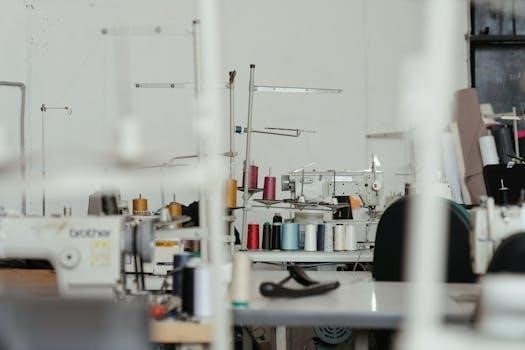
sewing machine parts and functions pdf
Sewing Machine Schematics and Diagrams
A sewing machine schematic is a visual tool depicting internal components and connections. Diagrams help identify parts like the needle and bobbin. These schematics assist in machine setup and adjustments, aiding sewing projects.
Understanding Sewing Machine Diagrams
Sewing machine diagrams are essential for comprehending how the machine operates. They visually represent the internal components and their interconnections. These diagrams allow users to quickly locate parts, such as the needle, presser foot, and bobbin. Understanding these diagrams is crucial for correct machine setup and making necessary adjustments. By studying the layout, sewers can ensure the machine is functioning correctly and troubleshoot potential issues. This knowledge facilitates successful sewing projects. Diagrams provide a clear view of how various parts work together.
Purpose of a Sewing Machine Schematic
The primary purpose of a sewing machine schematic is to provide a visual guide to the machine’s internal workings. It enables users to identify and locate specific parts quickly, such as the thread tension dial and feed dogs. Schematics are invaluable for setting up the machine and performing necessary adjustments for various sewing projects. They help users understand how different components interact. This understanding is crucial for both basic sewing tasks and for troubleshooting issues. Ultimately, schematics promote efficient and effective use of the sewing machine. They offer a clear visual aid.
Essential Sewing Machine Parts
Every sewing machine includes essential components like the needle, presser foot, and bobbin. These parts, often detailed in manuals, are crucial for proper machine function and sewing.
Identifying Key Components
Understanding a sewing machine starts with recognizing its key components. The needle pierces the fabric, while the presser foot holds it in place. The bobbin supplies the lower thread, and the thread tension dial regulates thread flow. A thorough understanding of these parts ensures smooth operation and accurate stitch formation for your sewing projects. Properly identifying these components will make setup, maintenance, and troubleshooting much simpler, allowing for a more enjoyable sewing experience.
Standard Accessories Location
Standard sewing machine accessories are often stored in a designated location, typically within the extension table, also known as the accessories storage box. This convenient storage keeps essential tools, such as extra presser feet, bobbins, and screwdrivers, readily accessible. Knowing the location of these accessories allows for efficient setup and quick adjustments. Familiarizing yourself with where these items are kept will streamline your sewing process and prevent time wasted searching for essential parts during projects.
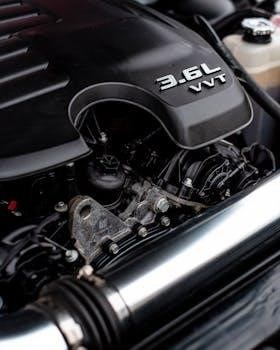
Front, Back and Top Views of Sewing Machine
Understanding the sewing machine involves viewing it from multiple angles. Front, back, and top perspectives show different parts. These views aid in identifying and naming specific components for easier understanding.
Detailed Parts Identification
The detailed identification of parts on a sewing machine is crucial for effective operation. This involves pinpointing components from various viewpoints—front, back, and top. Numbered items on diagrams simplify the naming process. Understanding the specific location of each part, such as the needle and presser foot, is essential. This detailed knowledge helps users correctly set up the machine and make necessary adjustments. Identifying parts enhances user proficiency and enables seamless sewing projects. These detailed identifications ensure users can confidently navigate their sewing machine.
Numbered Parts for Easy Naming
To simplify the identification and naming of sewing machine parts, diagrams often use a numbering system. Each component is assigned a unique number, correlating to a list or legend. This method makes it easier for users to learn and remember the different parts of the machine. Numbered parts allow for quick reference, facilitating better communication when discussing machine functions. Whether from the front, back, or top view, numbers help in pinpointing each element. This approach significantly enhances user understanding and simplifies the learning curve.
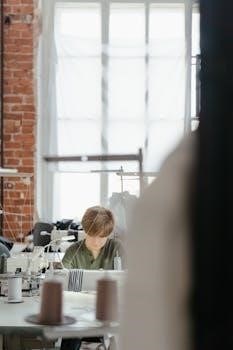
Sewing Machine Parts and Functions
A labeled diagram provides an overview of sewing machine components. It showcases how the needle, bobbin, and presser foot create stitches. Understanding these parts is essential for effective sewing.
Labeled Diagram Overview
The labeled diagram offers a clear visual guide to the various components of a sewing machine. It identifies key parts such as the needle, bobbin, presser foot, feed dogs, and thread tension dial. This overview helps users understand the function of each part and how they contribute to the overall stitching process. It’s a crucial reference for both beginners and experienced sewers looking to enhance their knowledge of machine anatomy. The diagram serves as a foundation for understanding how these parts interact.
How Parts Work Together
Understanding how the sewing machine parts interact is vital for effective sewing. The needle, guided by the needle bar, pierces the fabric, while the bobbin thread interlocks with the top thread to form a stitch. The presser foot holds the fabric in place as the feed dogs move it forward. The thread tension dial ensures consistent stitching. These components work in harmony to create a seamless and durable sewn seam, with each part playing a crucial role in the process.
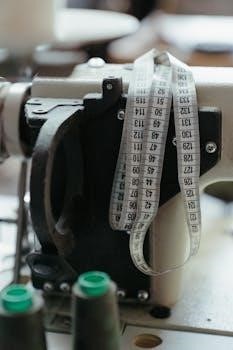
Main Parts of a Sewing Machine
Explore the main components of a sewing machine through detailed diagrams and labels. Learn about the functions of the foot controller, needle, bobbin, and spool holder, among others.
Detailed Diagram and Labels
Examine a comprehensive diagram showcasing the various parts of a sewing machine, each meticulously labeled for easy identification. This detailed view helps users understand the location and relationship between components like the needle, presser foot, feed dogs, and bobbin case. By studying this visual guide, users gain a clearer understanding of their machine’s inner workings and enhance their sewing skills. These labels are crucial for mastering your sewing machine.
Functions of Various Components
Understanding how the different parts work together is crucial for successful sewing. The needle pierces the fabric, while the presser foot holds it in place. Feed dogs move the material through the machine. The bobbin supplies thread from underneath, and the spool holder keeps the top thread in place. Proper function of all of these parts ensures the creation of secure, consistent stitches. These components work in harmony to produce a quality sewn product.
Basic Sewing Machine Parts
Learn about the essential 25 parts of a sewing machine with our handy list and diagram. A printable PDF worksheet is available for reference or teaching purposes.
25 Basic Parts List
This comprehensive list details the 25 fundamental components of a sewing machine. It includes crucial elements such as the needle, presser foot, bobbin, and spool pin, which work together to form stitches. Understanding each part’s role is key to mastering sewing techniques and troubleshooting. This list is designed to enhance your knowledge and skills for sewing projects, and it ensures that you are familiar with the basic components and their functions. It will help you navigate your machine and complete various tasks more efficiently.
Printable PDF Worksheet
A printable PDF worksheet is available to help you learn the 25 basic parts of a sewing machine. This resource offers a convenient way to study and familiarize yourself with each component. The worksheet is designed for easy access and can be used for reference or teaching purposes. This tool can be used at home or in a classroom setting, and it ensures you have a visual aid to help you learn. The document enhances understanding through labeling and identification practice for all essential sewing machine components;
Sewing Machine Parts Guide
This guide provides the names and functions of various sewing machine parts, aiding in mastering the machine. Understanding these components enhances sewing skills and machine operation.
Names and Functions
Explore the names and functions of key sewing machine parts. Learn how the needle, bobbin, and presser foot contribute to stitch formation. Understand the roles of the feed dogs and thread tension dial. Discover how each component works together, from the spool holder to the foot controller. Master these elements to enhance your sewing skills. This knowledge is essential for effective machine operation and successful sewing projects; Each part plays a vital and unique role in the overall sewing process.
Mastering the Machine
Understanding the names and functions of sewing machine parts is crucial for mastering the machine. Familiarity with each component allows for precise control and efficient sewing. By grasping how parts work together, you can troubleshoot issues and enhance your sewing skills. This knowledge empowers you to tackle diverse projects with confidence. Learn the intricacies of the machine to achieve professional results. Mastering the machine is key to unlocking your full sewing potential and creative expression.
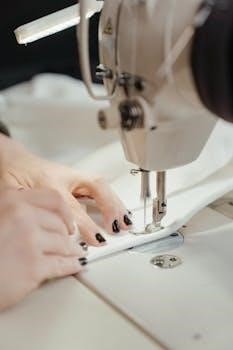
Manual and Parts
The instruction manual is essential, offering guidance on machine parts and safety. It includes parts diagrams and usage instructions. Always refer to your manual before operating the machine.
Instruction Manual Importance
The instruction manual is crucial for understanding your specific sewing machine model. It provides detailed diagrams and explanations of each part, ensuring you can properly operate and maintain your machine. The manual includes essential safety precautions, guiding you through safe usage. Referencing the manual helps in troubleshooting issues and maximizing the machine’s performance, making it an indispensable resource for any user. It is critical to read before using the machine.
Safety Precautions
Always read the instruction manual carefully before operating your sewing machine. The sewing machine is an electrical appliance when used with an adaptor. Ensure the machine is unplugged when not in use or when making adjustments. Keep fingers away from moving parts, especially the needle area, to prevent injury. Supervise children when they are near the machine, and never leave the machine unattended when in use. Adhering to these precautions ensures safe operation.
Smith Middle School Sewing Machine Parts
Smith Middle School machines include a reverse lever, pattern selector, and stitch length regulator. These parts are crucial for controlling stitch direction and appearance, enhancing sewing projects.
Reverse Lever, Pattern Selector, Stitch Length Regulator
The reverse lever allows for backstitching, securing seams. The pattern selector chooses different stitch types, like zigzag. The stitch length regulator controls the length of each stitch, affecting fabric appearance. These three components are very important for a successful sewing project. They give the user control over how the fabric will be sewn. These components are often located next to each other.
Setting up the Machine
To begin, set your machine for a straight stitch. Place the fabric carefully under the presser foot, ensuring it is aligned; Prepare for a smooth sewing experience.
Preparing for Straight Stitch
To prepare for a straight stitch, ensure the machine is properly threaded with the correct thread and the bobbin is correctly placed. Select the straight stitch option on the machine’s pattern selector. Adjust the stitch length regulator as required for your fabric, and check the needle is appropriate for your fabric type. Verify the presser foot is lowered and the tension is set correctly. Now, you are ready to start your stitching.
Fabric Placement
When placing fabric, gently position it beneath the presser foot, ensuring the edge aligns with the desired seam allowance. Lower the presser foot to hold the fabric in place. Make certain the fabric is lying flat on the feed dogs and not bunched up. Guide the fabric as you sew, applying light and even pressure. Avoid pulling or pushing the fabric, instead letting the machine feed it smoothly. This will help ensure a straight and even seam.
Related Posts

lotf pdf
Get the Lord of the Flies PDF for free! Download the full eBook, study guide, and analysis to enhance your reading experience.

house tree person interpretation free pdf
Discover the deep symbolism behind house, tree, and person interpretations. Get your free PDF guide now and uncover the secrets!
gingerbread house coloring pages pdf
Download free gingerbread house coloring pages in PDF! Perfect for kids and adults, these festive designs bring holiday cheer. Print and color now!